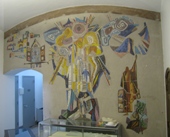Our Building
The sanctuary was built over a three-year period and dedicated in 1970. Designed by Armand Bartos, the distinguished architect of The Sacred of The Book in Jerusalem, which houses The Dead Sea Scrolls, this section of our synagogue was cited in Architectural Review as “an outstanding example of modern synagogue architecture.”
In the Sanctuary
The bimah wall, ark and eternal light are a memorial to the Holocaust Jews, entitled The White Flame of the Six Milllion. It is by world-renowned artist Louise Nevelson z”l, who designed a total environment for our sanctuary to stimulate the imagination without disturbing meditation.
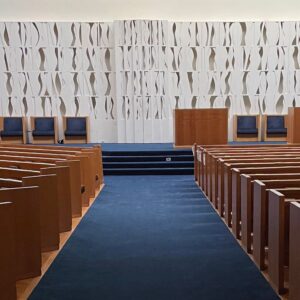
Elsie K. Rudin Judaica Museum
The Elsie K. Rudin Judaica Museum collection is comprised of both Judaic artifacts and special artwork which have been amassed over the past sixty years into an important and nationally well-known synagogue museum collection.
After the Shoah, Rabbi Jacob Philip Rudin z”l began to collect significant Judaica artifacts at major auction houses such as Sotheby’s and Christies. This need to collect orphaned Judaica for synagogues was shared by a number of Rabbi Rudin’s colleagues throughout the country as well. Members of Temple Beth-El either paid for or endowed these artifacts in memory of loved ones or in honor of special family events such as brit milah, b’nei mitzvah and weddings of children and grandchildren.
The museum’s collection of antique Judaica, dating from as early as the 16th into the 20th centuries, includes a large number of besomin (spice containers), yadayim (Torah pointers), kiddush cups, tzedakah containers, chanukiot (Chanukah lamps) and various artifacts used in family religious observances.
The Elsie K. Rudin Judaica Museum was named after Rabbi Rudin’s late wife and was dedicated in 1960. A portrait of Mrs. Rudin by Tully Filmus graces one of the walls in the present museum in the main sanctuary level of the building which had been designed by world famous architect Armand Bartos. Louise Nevelson, noted 20th century sculptor, created the enormous bema wall as well as the ner tamid in the sanctuary. A model of the bema wall and photographs, as well, were featured in the 2007 Nevelson retrospective exhibition at The Jewish Museum in New York City. Nevelson was brought to Temple Beth-El of Great Neck by longtime members Dr. Seymour Meyer z”l and his wife Beth.
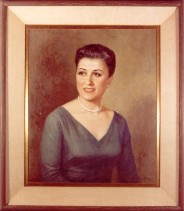
Portrait of Elsie K. Rudin by Tully Filmus
In the early 1950s, temple member Norma Levitt discovered the artist Ilya Schor and brought him and his work to Great Neck. Schor became one of the most significant Judaic artists of the middle of the 20th century; a true Renaissance man, Schor was a painter, engraver, sculptor, goldsmith and silversmith. He illustrated, with wood engravings, numerous books by Abraham Joshua Heschel. The first piece which Norma bought for the temple’s collection was a pewter seder plate crafted out of an antique Dutch pewter salver.
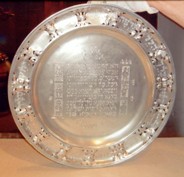
Pewter Seder Plate by Ilya Schor
Recognized in the 1960s by The Jewish Museum in a retrospective of Schor’s work, the 36-panel doors for the aron hakodesh in the Rudin Chapel are generally recognized as Schor’s masterpiece. Each of the 36 panels portrays in his unique style the 36 lamed vovniks (righteous people) of the Torah. Norma Levitt and Esther Kaufman are credited for beginning the contemporary Judaica art collection and were certainly lamed vovniks of their generation. Temple Beth-El of Great Neck possesses one of the finest collections of Schor’s work in the world — each piece lovingly paid for and presented by temple families, continuing the tradition started by Rabbi Rudin so many years ago.
In that same philanthropic spirit of beautifying our holy space, the temple’s 20th century art collection has been and continues to be endowed by members. The collection includes works by, among others, Robert Indiana, Mordechai Rosenstein, Avram Ebgi, Moshe Gat, Moshe Castel, Tully Filmus, David Palumbo, Ivan Schwebel, Sandu Lieberman and Nathan Rapoport.
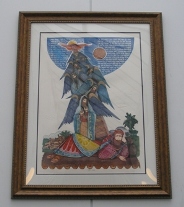
“Jacob’s Ladder” etching with intaglio by Amram Ebgi
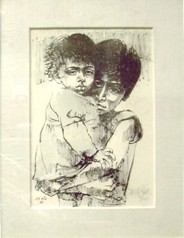
“Mother and Child” lithograph by Moshe Gat
For a number of years, The Elsie K. Rudin Judaica Museum has presented to the public art exhibits such as the 56 parashot (Torah Portions) created by Israeli artist Michal Meron, sculpture by famous Israeli sculptor Frank Meisler, a large exhibition celebrating the history of Lilith Magazine, and a remarkable retrospective of the works in all media by the late Ilya Schor.
When the Elsie K. Rudin Judaica Museum opened and inaugurated its new Art Gallery, four to five exhibitions were presented annually. The Gallery has shown solo exhibitions of works by Carla Gudeon, Tully Filmus and his two sons, Michael and Stephen, who are also accomplished painters, the mixed media paintings of Carol Buchman of Memphis Tennessee, and the extraordinary photographs of Israeli Neil Folberg. During the winter months, the temple’s Museum hosts a Members Art Salon, featuring the works of members who are professional-level artists. Not only are these well-received exhibitions, they also are intended to follow the mitzvah (commandment from Torah) of beautifying our mishkan (Holy Tabernacle). They are used as well to educate and enlighten both adults and children, a significant part of Temple Beth-El’s mission.
Special Aquisition: Hillel and Shammai
Longtime members Merna Hausman Miller z”l and Richard Miller donated an important bronze sculpture of Hillel and Shammai to the Elsie K. Rudin Judaica Museum of Temple Beth-El of Great Neck. This gift represents at least three generations of a founding family of the temple. Samuel and Vera Hausman were founders; Merna was confirmed at Temple Beth-El, as were their three children who are now adults and living elsewhere. Hillel and Shammai includes a plaque dedicated to Samuel Hausman, a philanthropist not only to Temple Beth-El of Great Neck but to other charitable institutions as well, from “his friends in the Leather Goods Industry.”
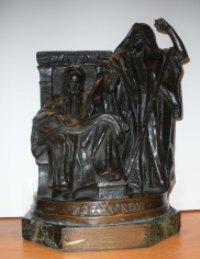
Hillel and Shammai by Jules L. Butensky
Hillel and Shammai is a dramatic bronze piece evoking the history of two great Jewish rabbi philosophers of the first century of the common era. Each founded his own academy. Not only did these two famously argue, but their students and followers continued their argumentative philosophies for several centuries. Two of their most famous arguments were about the placement of the mezuza on the doorpost and about the direction that the Chanukah lights were lit in the Chanukiah. In both instances, Hillel won the arguments and two thousand years later we still follow his way. Hillel was reputed to have been more liberal in his views and quieter in personality, while Shammai was more strict and with a fiery temper.
Hillel and Shammai was created by acclaimed sculptor Jules L. Butensky (1871-1947). Although born in Lithuania (or Russia, depending upon the day of the week), Butensky was considered to be an American artist. At 18, he entered the Imperial Academy of Art in Vienna and, about 1904, emigrated to America. Financier and philanthropist Jacob Schiff arranged for a commission by the Metropolitan Museum of Art for Butensky to recreate his Universal Peace sculpture in monumental form which was unveiled in 1911 and is still in the Met’s collection.
Butensky’s Hillel and Shammai, while powerful, realistic and filled with the drama of the two philosophers discussing text, also indicates the Art Nouveau sensibility of elongated sinuous forms popular during the period of the early 20th century.
Temple Beth-El and its Elsie K. Rudin Judaica Museum are, indeed, very fortunate to have this piece in its collection representing the important period of Jewish history of two thousand years ago and the artistic excellence of an American Jewish sculptor of Art Nouveau. It is also a wonderful example of a family’s longtime devotion to our synagogue, a teaching tool about Hillel and Shammai, but more importantly a teaching tool about Jewish philanthropy. We are grateful to Richard Miller for this gift.
Select Temple Art and Architecture
The Sanctuary Torah Scroll Covers
The Torah scroll covers were designed by artist Ina Golub and the needlepoint work was done by members of the congregation.
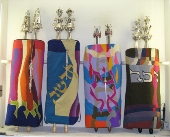
In the Sanctuary Lobby
Representation of the Wester Wall of King Solomon’s Temple. Red and black basalt painting by Moishe Castel. A major work of Castel’s is the sculpture in Israel’s Knesset building.
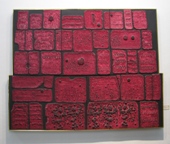
The Flame, an aluminum sculpture by Dr. Seymour W. Meyer z”l, noted physician, sculptor and Temple Beth-El congregant, give the feeling of arms lifted up to heaven in prayer, in an abstract form.
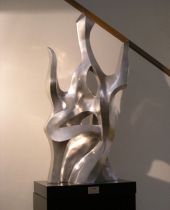
In the Rabbi Jacob Philip Rudin Chapel
Ilya Schor, creator of the silver doors for the ark of our Chapel, was a wood engraver, painter, and master silversmith. Depicted here are 36 righteous people in the Torah who are portrayed in a contemporary design.
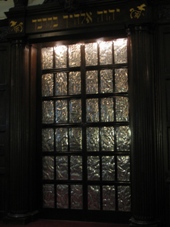
The Mural by Perli Pelzig
The mural, a mosaic tile wall, created and executed by famed artist Perli Pelzig, depicts, in a magnificent art form, the biblical narrative concerning Jacob’s dream. It can be found in the space occupied by the Judaica Shop next to the Rudin Chapel.
